第二届全国英语教师教学设计大赛参赛教案
- 格式:doc
- 大小:31.50 KB
- 文档页数:7
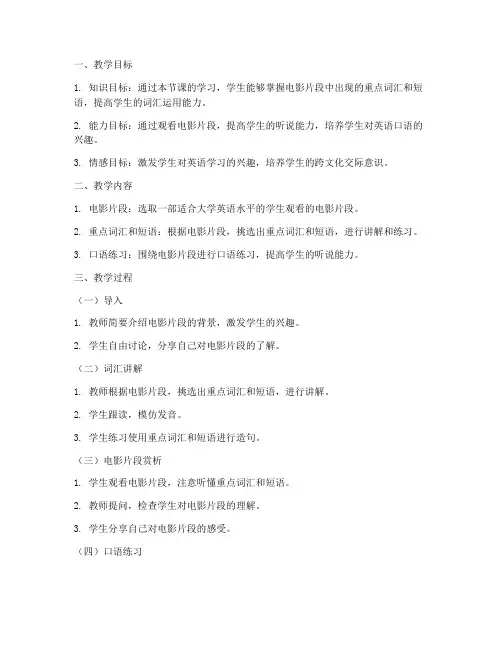
一、教学目标1. 知识目标:通过本节课的学习,学生能够掌握电影片段中出现的重点词汇和短语,提高学生的词汇运用能力。
2. 能力目标:通过观看电影片段,提高学生的听说能力,培养学生对英语口语的兴趣。
3. 情感目标:激发学生对英语学习的兴趣,培养学生的跨文化交际意识。
二、教学内容1. 电影片段:选取一部适合大学英语水平的学生观看的电影片段。
2. 重点词汇和短语:根据电影片段,挑选出重点词汇和短语,进行讲解和练习。
3. 口语练习:围绕电影片段进行口语练习,提高学生的听说能力。
三、教学过程(一)导入1. 教师简要介绍电影片段的背景,激发学生的兴趣。
2. 学生自由讨论,分享自己对电影片段的了解。
(二)词汇讲解1. 教师根据电影片段,挑选出重点词汇和短语,进行讲解。
2. 学生跟读,模仿发音。
3. 学生练习使用重点词汇和短语进行造句。
(三)电影片段赏析1. 学生观看电影片段,注意听懂重点词汇和短语。
2. 教师提问,检查学生对电影片段的理解。
3. 学生分享自己对电影片段的感受。
(四)口语练习1. 教师设计一个与电影片段相关的口语话题,如:“如果你是这个电影中的角色,你会怎么做?”2. 学生分组进行口语练习,教师巡回指导。
3. 学生展示练习成果,其他学生评价。
(五)总结与反思1. 教师对本节课进行总结,强调重点词汇和短语。
2. 学生分享学习心得,反思自己的学习过程。
四、教学评价1. 课堂参与度:观察学生在课堂上的发言和互动情况。
2. 词汇掌握情况:检查学生对重点词汇和短语的掌握程度。
3. 口语表达能力:评价学生在口语练习中的表现。
五、教学反思1. 教师应根据学生的实际情况,调整教学内容和方法。
2. 注重培养学生的跨文化交际意识,提高学生的听说能力。
3. 营造轻松、愉快的课堂氛围,激发学生的学习兴趣。
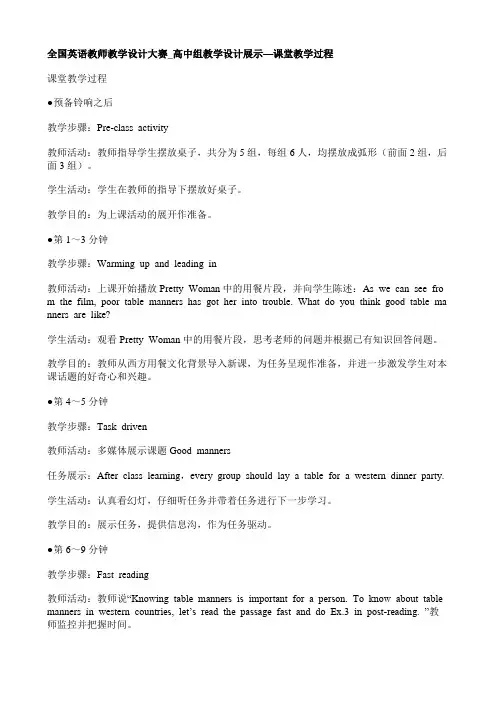
全国英语教师教学设计大赛_高中组教学设计展示—课堂教学过程课堂教学过程●预备铃响之后教学步骤:Pre-class activity教师活动:教师指导学生摆放桌子,共分为5组,每组6人,均摆放成弧形(前面2组,后面3组)。
学生活动:学生在教师的指导下摆放好桌子。
教学目的:为上课活动的展开作准备。
●第1~3分钟教学步骤:Warming up and leading in教师活动:上课开始播放Pretty Woman中的用餐片段,并向学生陈述:As we can see fro m the film, poor table manners has got her into trouble. What do you think good table ma nners are like?学生活动:观看Pretty Woman中的用餐片段,思考老师的问题并根据已有知识回答问题。
教学目的:教师从西方用餐文化背景导入新课,为任务呈现作准备,并进一步激发学生对本课话题的好奇心和兴趣。
●第4~5分钟教学步骤:Task driven教师活动:多媒体展示课题Good manners任务展示:After class learning,every group should lay a table for a western dinner party.学生活动:认真看幻灯,仔细听任务并带着任务进行下一步学习。
教学目的:展示任务,提供信息沟,作为任务驱动。
●第6~9分钟教学步骤:Fast reading教师活动:教师说“Knowing table manners is important for a person. To know about table manners in western count ries, let’s read the passage fast and do Ex.3 in post-reading. ”教师监控并把握时间。
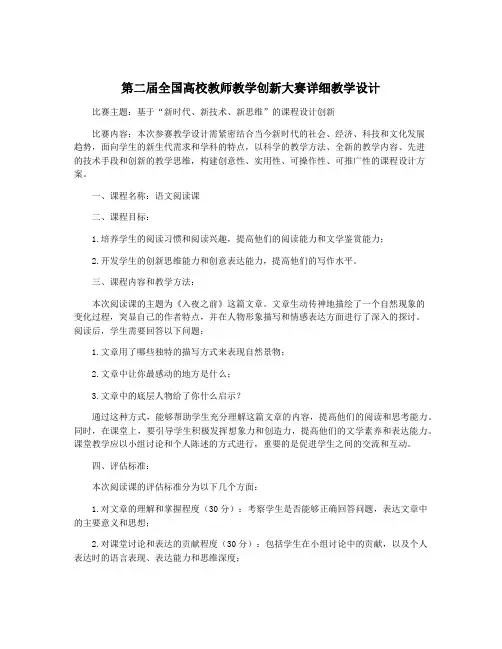
第二届全国高校教师教学创新大赛详细教学设计比赛主题:基于“新时代、新技术、新思维”的课程设计创新比赛内容:本次参赛教学设计需紧密结合当今新时代的社会、经济、科技和文化发展趋势,面向学生的新生代需求和学科的特点,以科学的教学方法、全新的教学内容、先进的技术手段和创新的教学思维,构建创意性、实用性、可操作性、可推广性的课程设计方案。
一、课程名称:语文阅读课二、课程目标:1.培养学生的阅读习惯和阅读兴趣,提高他们的阅读能力和文学鉴赏能力;2.开发学生的创新思维能力和创意表达能力,提高他们的写作水平。
三、课程内容和教学方法:本次阅读课的主题为《入夜之前》这篇文章。
文章生动传神地描绘了一个自然现象的变化过程,突显自己的作者特点,并在人物形象描写和情感表达方面进行了深入的探讨。
阅读后,学生需要回答以下问题:1.文章用了哪些独特的描写方式来表现自然景物;2.文章中让你最感动的地方是什么;3.文章中的底层人物给了你什么启示?通过这种方式,能够帮助学生充分理解这篇文章的内容,提高他们的阅读和思考能力。
同时,在课堂上,要引导学生积极发挥想象力和创造力,提高他们的文学素养和表达能力。
课堂教学应以小组讨论和个人陈述的方式进行,重要的是促进学生之间的交流和互动。
四、评估标准:本次阅读课的评估标准分为以下几个方面:1.对文章的理解和掌握程度(30分):考察学生是否能够正确回答问题,表达文章中的主要意义和思想;2.对课堂讨论和表达的贡献程度(30分):包括学生在小组讨论中的贡献,以及个人表达时的语言表现、表达能力和思维深度;3.文学素养和创造力的表现(40分):考察学生是否能够以独特的思维和语言表现,展现自己对文章的理解和思考。
五、课程推广:。
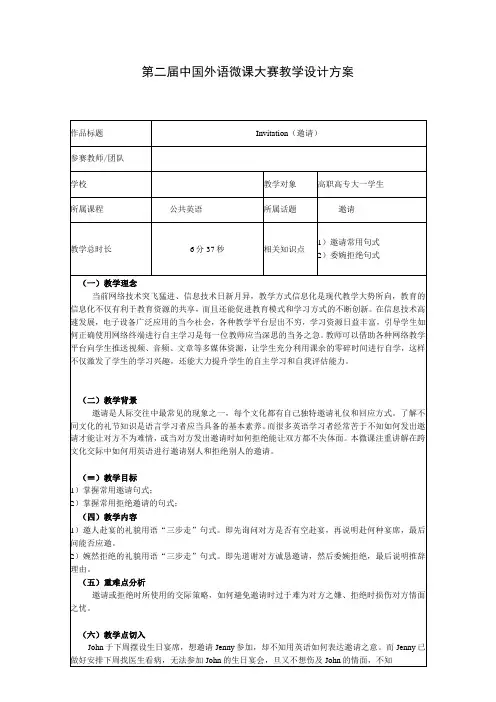
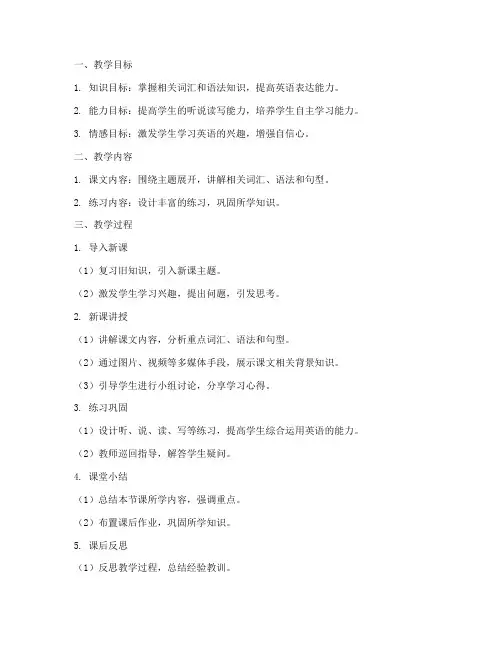
一、教学目标1. 知识目标:掌握相关词汇和语法知识,提高英语表达能力。
2. 能力目标:提高学生的听说读写能力,培养学生自主学习能力。
3. 情感目标:激发学生学习英语的兴趣,增强自信心。
二、教学内容1. 课文内容:围绕主题展开,讲解相关词汇、语法和句型。
2. 练习内容:设计丰富的练习,巩固所学知识。
三、教学过程1. 导入新课(1)复习旧知识,引入新课主题。
(2)激发学生学习兴趣,提出问题,引发思考。
2. 新课讲授(1)讲解课文内容,分析重点词汇、语法和句型。
(2)通过图片、视频等多媒体手段,展示课文相关背景知识。
(3)引导学生进行小组讨论,分享学习心得。
3. 练习巩固(1)设计听、说、读、写等练习,提高学生综合运用英语的能力。
(2)教师巡回指导,解答学生疑问。
4. 课堂小结(1)总结本节课所学内容,强调重点。
(2)布置课后作业,巩固所学知识。
5. 课后反思(1)反思教学过程,总结经验教训。
(2)关注学生学习情况,调整教学策略。
范文:一、教学目标1. 知识目标:掌握“梦想”、“努力”、“成功”等词汇,理解“坚持不懈”的语法结构。
2. 能力目标:提高学生的听说读写能力,培养学生自主学习能力。
3. 情感目标:激发学生学习英语的兴趣,增强自信心。
二、教学内容1. 课文内容:讲述一个关于梦想、努力和成功的故事。
2. 练习内容:听、说、读、写相关词汇和句型。
三、教学过程1. 导入新课(1)复习旧知识,如:“梦想”、“努力”、“成功”等。
(2)提问:“你们有什么梦想?你们是如何努力实现梦想的?”(3)引入新课主题:“坚持不懈,梦想成真”。
2. 新课讲授(1)讲解课文内容,分析重点词汇、语法和句型。
(2)通过图片展示故事背景,引导学生了解故事情节。
(3)小组讨论,分享学习心得。
3. 练习巩固(1)听录音,回答问题,提高听力能力。
(2)小组合作,完成对话练习,提高口语表达能力。
(3)阅读课文,找出关键词汇和句型,进行仿写。
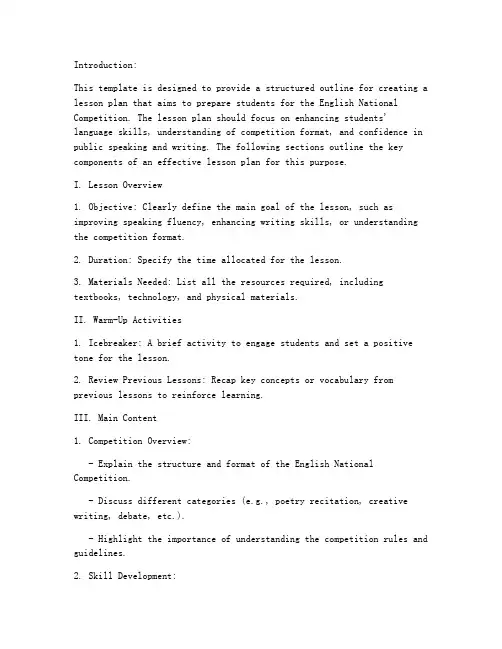
Introduction:This template is designed to provide a structured outline for creating a lesson plan that aims to prepare students for the English National Competition. The lesson plan should focus on enhancing students' language skills, understanding of competition format, and confidence in public speaking and writing. The following sections outline the key components of an effective lesson plan for this purpose.I. Lesson Overview1. Objective: Clearly define the main goal of the lesson, such as improving speaking fluency, enhancing writing skills, or understanding the competition format.2. Duration: Specify the time allocated for the lesson.3. Materials Needed: List all the resources required, including textbooks, technology, and physical materials.II. Warm-Up Activities1. Icebreaker: A brief activity to engage students and set a positive tone for the lesson.2. Review Previous Lessons: Recap key concepts or vocabulary from previous lessons to reinforce learning.III. Main Content1. Competition Overview:- Explain the structure and format of the English National Competition.- Discuss different categories (e.g., poetry recitation, creative writing, debate, etc.).- Highlight the importance of understanding the competition rules and guidelines.2. Skill Development:- Speaking:- Conduct role-playing exercises to practice different speaking scenarios.- Provide feedback on pronunciation, fluency, and confidence.- Encourage students to record themselves and analyze their performances.- Writing:- Guide students through the process of writing for different competition categories.- Offer constructive criticism and suggest ways to improve their writing.- Teach students how to structure their essays, poems, or scripts effectively.3. Group Work:- Organize small group activities where students can collaborate on preparing for the competition.- Assign roles such as scriptwriter, speaker, and coach within each group.- Facilitate discussions and provide support as needed.IV. Practice Activities1. Speaking Practice:- Have students deliver short speeches or presentations on a given topic.- Encourage peer-to-peer feedback and offer constructive criticism.- Record and playback speeches to analyze areas of improvement.2. Writing Practice:- Assign writing tasks that mimic the competition format.- Set specific word limits and time constraints to simulate competition conditions.- Review and discuss the completed writing pieces as a class.V. Feedback and Reflection1. Individual Feedback:- Provide individual feedback on speaking and writing skills.- Offer suggestions for improvement and encourage students to set personal goals.2. Class Discussion:- Facilitate a discussion on the challenges faced and the strategies used to overcome them.- Encourage students to share their experiences and learn from each other.VI. Conclusion1. Summary of Key Points:- Recap the main topics covered in the lesson.- Reinforce the importance of continuous practice and preparation.2. Homework Assignment:- Assign specific tasks to be completed outside of class, such as writing a short story or preparing a speech.VII. Assessment1. Formative Assessment:- Monitor student progress through class participation, speaking and writing exercises, and peer feedback.- Keep a record of student improvement over time.2. Summative Assessment:- Evaluate students' performance in the English National Competition itself.- Consider factors such as speaking fluency, writing quality, and adherence to competition rules.Conclusion:This template serves as a comprehensive guide for designing a lesson plan that effectively prepares students for the English National Competition. By focusing on skill development, practice, and constructive feedback, educators can help their students achieve their full potential and excel in the competition.。

第二届全国英语教师教学设计大赛参赛教案How’s the weather ?(七年级下Unit 6 Section B教案)四川省威远县第一初级中学黄正明组别:初中教案组Ⅰ.T eaching Aims and Demands1.Knowledge ObjectsKey Vocabulary:hot,cold,cool,warm,humid2.Ability ObjectsTrain students’listening skill.Train students’speaking skill 3.Moral ObjectDo in Rome as Romans do.Ⅱ.Teaching Key PointsThe key vocabulary. How,What questions.Ⅲ.Teaching DifficultiesTrain students’listening skill.Train students’speak ing skill Ⅳ.Teaching MethodsScene teaching method.Listening method.Pairwork.Ⅴ.Teaching AidsSlides showing hot,cold,warm,humid.Pictures .A tape recorder. Ⅵ.Teaching ProceduresStep ⅠRevisionBrainstorm students with questions How’s it going?and How’s the weather so that they can have a review of the words and target language learned in the previous classes.Step Ⅱ1aBefore class make slides showing hot,cold,cool,warm andhumid from the Internet ,magazines or newspapers. Now turn on “My Computer”,left c lick Flash H Show the slides in turn,teach students to practice the words hot ,cold,cool,warm and humid.Write the words on the blackboard.Show the pictures to the students.Point to the words randomly.Each time he or she finds a picture to go with a word,he or she has to say the word. Call students’attention to the pictures in the book.Ask students to tell what the weather is like in each picture using the words learned just now.For example,for Picture a,a student may say,it’s cold.Point out the numbered list of words in the box.Invite a student to read them aloud to the class.Say,please match the words with the pictures.Write the letter of each picture in front of the word it goes with.Point out the sample answers.Students finish the task individually.Check the answers.Answers1.d2.a3.e4.b5.cStep Ⅲ1bCall attention to the conversation in the speech bubbles.Invite a pair of students to read it to the class.Write the conversation on the blackboard.Say, Now let’s work in pairs. Start by reading the s ample conversation .Then ask and answer questions about the weather in the pictures in activity 1a.Students work in pairs. As the pairs are workingtogether ,move around the classroom listening and offering assistance if needed. Ask several pairs to present their conversations to the class.(This activity provides oral practice using the target language.) Step Ⅳ2aDraw attention to the chart. Read the names Maria and Sam and the headline. How’s it going ?to the class.Say ,I’ll play a recording of the conv ersation .Listen carefully and write down the answers Maria and Sam give to the question How’s it going?Play the recording twice .Students listen and write down the answers the second time they hear it.Check the answers.AnswersMaria :pretty goodSam: greatTapescriptMaria: Hello, Sam ?Sam: Maria? Hi! Where are you?Maria: I’m in Mexico !I’m calling to say happy birthday! Sam: Oh, thanks!Maria: So, how’s it going there?Sam :Great! How’s it going with you?Maria: Pretty good. What are you doing?Sam:I’m having a party .My whole family is here.Maria:Oh,that sounds like fun.How’s the weather?Sam: Terrible .It’s cold and raining .How’s the weather there? Maria:Hot.Hot and humid,and sunny.Sam: Sounds good…Maria: Uh-huh.Sam: So, what are you doing in Mexico?Maria: I’m visiting my grandmother…(This activity provides listening and writing practice using the target language.)Step Ⅴ2bTell students to look at the chart again.Read the headlines what are you doing? and how’s the weather ?to the class.Say,I’ll play the same recording once more.This time you are to listen and write down the answers Maria and Sam give to the questions what are you doing?and How’s the weather?Play the recording at least twice and use the pause button .Students listen and write down the answers in the chart.Check the answers.AnswersMaria: I’m visiting my grandmother .It’s hot, humid and sunny.(This activity provides listening and writing practice using the target language.)Step Ⅵ2cSay, you are asked to role play conversations between Maria and Sam in pairs.Suppose one is Maria and the other is Sam .Take turns asking each other the questions how’s it going ?What are you doing? and How’s the weather ?You may use the information in the chart in activity 2a.Invite two more advanced students to demonstrate a conversation to the class if necessary.Get students to role play conversations .The teacher writes a sample conversation on the blackboard so that students may use it as a model .Afterthat ,move around the room offering language support as necessary .Ask one or two pairs to share their conversations with the class.(This activity provides listening and speaking practice using the target language.)Step ⅦsummarySay,in this class we’ve learned another five words describing the weather, which are hot ,cold ,cool ,warm and humid .Then we’ve done much listening and oral practice using the target language on the blackboard.Step ⅧhomeworkMake up sentences with the words describing the weather each.Step ⅨBlackboard Des ign。
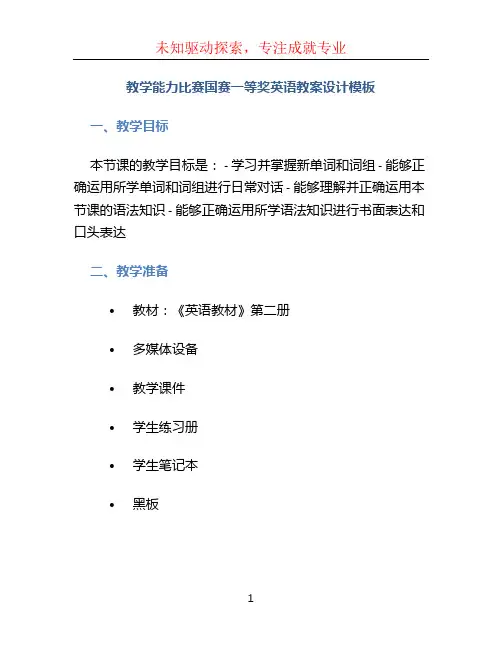
教学能力比赛国赛一等奖英语教案设计模板一、教学目标本节课的教学目标是: - 学习并掌握新单词和词组 - 能够正确运用所学单词和词组进行日常对话 - 能够理解并正确运用本节课的语法知识 - 能够正确运用所学语法知识进行书面表达和口头表达二、教学准备•教材:《英语教材》第二册•多媒体设备•教学课件•学生练习册•学生笔记本•黑板三、教学步骤1. 导入新知•利用多媒体设备展示一段视频,引起学生兴趣,同时激发他们对英语学习的兴趣。
2. 学习新词汇和词组•利用教学课件展示新词汇和词组的图片,并教授其发音和意义。
•运用游戏形式,在学生中进行词汇和词组的复习和巩固。
3. 学习语法知识•利用教学课件介绍本节课的语法知识,包括使用频率最高的时态、句子结构和常用的句型。
•以填空的形式进行练习,帮助学生熟悉运用语法知识。
•引导学生通过组织句子,灵活运用所学语法知识。
4. 听力训练•利用教材中的听力材料进行听力训练,要求学生听懂并抓住关键信息。
•分组进行对话练习,帮助学生巩固听力和口语表达能力。
5. 读写训练•指导学生阅读课文并回答相关问题,帮助理解文章内容。
•布置作文任务,要求学生按照指定要求,运用所学语法知识进行书面表达。
6. 互动交流•运用小组讨论的方式,让学生展示他们的作文,并相互进行点评和修改。
•引导学生在小组中进行英语对话,锻炼他们的口语表达能力。
7. 小结和反思•总结本节课所学的重点知识和技能,并与学生一起回顾学习过程中的困难和收获。
•提醒学生需要继续巩固和运用所学知识。
四、板书设计1. Vocabulary(词汇)- Word 1- Word 2- Word 32. Grammar(语法)- Tense 1- Tense 2- Sentence Structure3. Conversation Practice(对话练习)- Example 1- Example 24. Writing Practice(写作练习)- Essay Topic5. Group Discussion(小组讨论)- Topic 1- Topic 2五、课后作业•完成学生练习册上的相关练习•以小组为单位,准备下一节课的相关话题演讲通过本节课的教学活动,学生将能够更好地掌握新单词和词组,理解并运用语法知识,提高听说读写的能力。

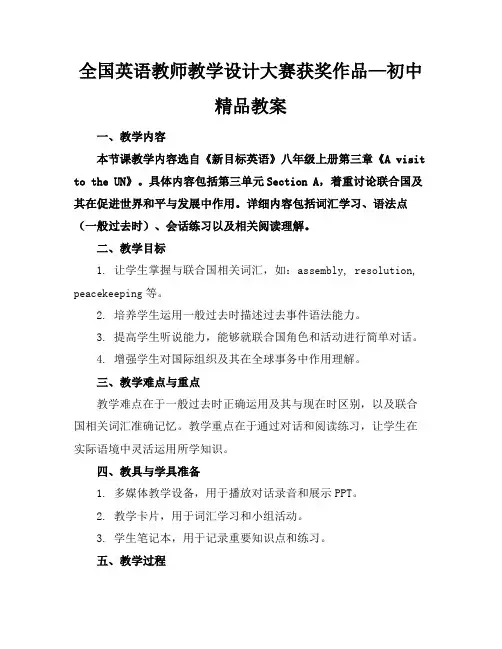
全国英语教师教学设计大赛获奖作品—初中精品教案一、教学内容本节课教学内容选自《新目标英语》八年级上册第三章《A visit to the UN》。
具体内容包括第三单元Section A,着重讨论联合国及其在促进世界和平与发展中作用。
详细内容包括词汇学习、语法点(一般过去时)、会话练习以及相关阅读理解。
二、教学目标1. 让学生掌握与联合国相关词汇,如:assembly, resolution, peacekeeping等。
2. 培养学生运用一般过去时描述过去事件语法能力。
3. 提高学生听说能力,能够就联合国角色和活动进行简单对话。
4. 增强学生对国际组织及其在全球事务中作用理解。
三、教学难点与重点教学难点在于一般过去时正确运用及其与现在时区别,以及联合国相关词汇准确记忆。
教学重点在于通过对话和阅读练习,让学生在实际语境中灵活运用所学知识。
四、教具与学具准备1. 多媒体教学设备,用于播放对话录音和展示PPT。
2. 教学卡片,用于词汇学习和小组活动。
3. 学生笔记本,用于记录重要知识点和练习。
五、教学过程1. 导入新课:通过展示联合国图片,引发学生思考其在国际事务中作用,自然引入新课。
小组讨论:让学生探讨联合国标志意义。
录音播放:听一段关于联合国工作对话,让学生预测对话内容。
2. 新知呈现:词汇教学:通过PPT展示和教学卡片,讲解并让学生练习新词汇。
语法讲解:以对话为例,讲解一般过去时用法。
3. 例题讲解:展示例题,解释一般过去时构造和应用。
让学生模仿例题,进行句子构造练习。
4. 随堂练习:分组对话练习:学生模拟联合国会议,进行角色扮演。
个人阅读理解:完成关于联合国阅读理解练习。
5. 巩固拓展:对话复述:学生复述所听对话,巩固词汇和语法。
角色扮演:学生模拟联合国代表,讨论国际问题。
六、板书设计板书将包括:1. 新词汇及其翻译。
2. 一般过去时构造和示例句子。
3. 联合国主要职能和活动。
七、作业设计1. 作业题目:编写一段关于联合国某次重要活动报道,至少包含5个新学词汇和一般过去时正确使用。
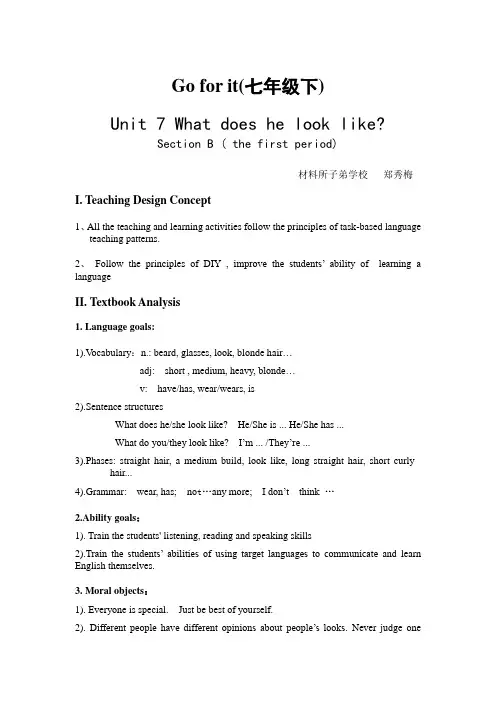
Go for it(七年级下)Unit 7 What does he look like?Section B ( the first period)材料所子弟学校郑秀梅I. Teaching Design Concept1、All the teaching and learning activities follow the principles of task-based languageteaching patterns.2、Follow the principles of DIY , improve the students’ ability of learning a languageII. Textbook Analysis1. Language goals:1).V ocabulary:n.: beard, glasses, look, blonde hair…adj: short , medium, heavy, blonde…v: have/has, wear/wears, is2).Sentence structuresWhat does he/she look like? He/She is ... He/She has ...What do you/they look like? I’m ... /They’re ...3).Phases: straight hair, a medium build, look like, long straight hair, short curlyhair...4).Grammar: wear, has; no t…any more; I don’t think…2.Ability goals:1). Train the students' listening, reading and speaking skills2).T rain the students’ abilities of using target languages to communicate and learn English themselves.3. Moral objects:1). Everyone is special. Just be best of yourself.2). D ifferent people have different opinions about people’s looks. Never judge oneperson by his appearance.3).Enable the students to corporate with others actively and have fun completing the tasks with others.III. Teaching main points and difficulties1). Describe people’s looks in different ways with the expressions in this Unit freely.2). How to make students to describe people’s looks in different ways.IV. Students learning situation analysis1) Students are interested in learning English,2) Students like to show themselves in class,V. Teaching and learning methods1) Task-based Language Teaching approach2) Situation approach and Communicative approach3) Students do it themselves actively (DIY)VI. Teaching procedures:Step 1. Today’s say ing (1分钟)Never judge one person by his appearance(students collected and wrote it on the blackboard before class. Then explain and read it in front of the class.)(学生收集英语谚语,板书讲解,提高兴趣,训练口语,展示自己,拓宽学科视野。
全国英语教师教学设计大赛获奖作品—初中优质教案一、教学内容本节课选自《新目标英语》八年级上册第三章“Now you see it, now you don’t”,具体内容包括:Section A1a2d,通过该部分学习,让学生掌握一般过去时用法,以及描述物体位置变化表达方式。
二、教学目标1. 让学生掌握一般过去时基本结构,并能运用该时态描述物体位置变化。
2. 培养学生通过观察、思考、交流等方式,运用所学英语知识解决实际问题能力。
3. 增强学生团队协作意识,提高英语口语表达能力。
三、教学难点与重点1. 教学难点:一般过去时运用及位置描述表达方式。
2. 教学重点:让学生在实际情境中运用所学知识进行有效沟通。
四、教具与学具准备1. 教具:多媒体课件、黑板、教学挂图等。
2. 学具:学生用书、练习册、文具等。
五、教学过程1. 导入:通过展示一个关于“神奇消失”魔术视频,激发学生兴趣,引导他们关注物体位置变化。
2. 呈现:呈现本节课主题,讲解一般过去时用法,让学生通过观察、思考、交流等方式,学会描述物体位置变化。
3. 讲解:结合教材内容,详细讲解一般过去时结构,以及位置描述表达方式。
4. 实践:设计小组活动,让学生用一般过去时描述物体位置变化,提高他们实际运用能力。
5. 巩固:进行随堂练习,检查学生对知识掌握情况,并及时进行反馈。
6. 作业布置:布置相关课后作业,巩固所学知识。
六、板书设计1. 板书主题:Now you see it, now you don’t!2. 内容:一般过去时结构:主语+动词过去式+其他描述物体位置变化表达方式:It was in/on/under七、作业设计1. 作业题目:(1)用一般过去时描述下列物体位置变化:a. The book was on the table, but now it’s on the chair.b. The keys were in the drawer, but now they are on the desk.(2)编写一段对话,描述你和你朋友在公园里玩捉迷藏游戏,运用一般过去时描述你们位置变化。
第二届全国高校教师教学创新大赛二等奖详细教学设计导读课程名称:概率论与数理统计授课教师简介:杨苗苗:理学博士,毕业于哈尔滨工业大学,现任教于齐鲁工业大学(山东省科学院)数学与人工智能学部,主持山东省自然科学基金1项;讲授《概率论与数理统计》、《应用随机过程》等课程。
主要研究领域为非线性泛函分析、偏微分方程等。
01课程整体思路1、基本信息《概率论与数理统计》是一门公共基础课,面向全校理、工、经管类本科二年级学生开设,48学时3学分,每学年授课对象超过5000人。
2、课程目标(1)价值塑造目标:坚定理想信念,厚植家国情怀,培养探索未知、追求真理、勇攀科学高峰的责任感和使命感,培养精益求精的大国工匠精神,激发科技报国的家国情怀和使命担当;(2)知识传授目标:掌握概率论(随机事件的概率、随机变量的分布、随机变量数字特征)和数理统计的(参数估计、假设检验)基本理论和基本方法,为后续专业课的学习和工作打下坚实的基础;(3)能力培养目标:能够对经济社会中的各种随机数据进行统计建模,运用统计方法解释生活中的各种随机现象,具有分析数据的统计素养,养成以“数据”为依据的求真务实精神,具有独立思考、创新意识和批判性思维。
3、教学痛点问题(1)传统大学数学公共课教学多以教师讲授为主,师生、生生之间的互动都非常有限,翻转课堂模式又不适合数学公共课教学,教学内容经典传统,但缺乏新意,不利于激发学生的学习兴趣;(2)“平时作业+期中考试+期末考试”的考核形式仍然比较单一。
“四新”时代,学生需要多元化的考核形式检验其学习效果、反映其协作创新能力,这是传统“作业+考试”的形式做不到的;(3)传统大学数学公共课教学多采用大班制授课,专业差异、人数众多的实际情况导致教师很难因材施教。
4、课程内容与资源的建设及应用情况团队选择省级一流课程——山东科技大学、北京科技大学的《概率论与数理统计》作为学生的线上学习资源,并对课程内容进行了重构。
教学过程教学反思本节课我主要想探讨新课标下如何注重学生的学习过程并进行有效的句型教学。
根据新课标初中英语听说、阅读与写作教学的现状,为了进一步提高教学的针对性和效果,我在英语教学中开始摸索将听说、阅读与写作教学作为一个整体来考虑,将阅读与写作教学中行之有效的各种方法进行优化组合,形成听说、阅读与写作联动的教学方法。
《新概念英语》的作者认为:“不写没有读过的语言,不读没有说过的语言,不说没有听过的话。
”我所实验的联动教学法的核心容是:以听说为基础,以阅读材料为指导,并将它们作为写作的基础。
同时,还能将写作教学的效果---学生习作,作为对学生学习效果的一种检验,从而达到听说教学、阅读教学与写作教学的联动,促进学生英语综合能力的提高。
本节课我以激发学生兴趣为前提, 鼓励学生大胆地使用英语;创设各种情景,使学生在掌握最基本的知识的同时,注意拓宽知识面,关注全体学生的学习情况,给他们自主学习和在真实的情景中,直接交流的自我发展空间;鼓励学生通过体验、实践等方式,发展听、说、读、写的综合能力;加强了对学生学习策略的指导,让他们在学习和使用的过程中逐步学会如何运用所学语言;关注学生情感,保护他们的自尊心和积极性,努力创造宽松、和谐的教学气氛。
一、本课的亮点分析1、教学目标设计突出了一个“明”字,即明确具体。
符合新课程标准的要求,以人的发展为本。
教学目标不但考虑了语言知识学习技能的培养,而且也考虑到了文化和情感教育。
2、教学过程设计突出了一个“清”字,即层次清楚。
教学结构严谨、环环相扣,过渡自然,时间分配合理,密度适中,效率高。
教学过程的主线非常清晰,明线是听(语言输入)→说(语言输出);读(语言输入)→写(语言输出),教学过程呈螺旋式上升,有梯度和一定厚度;暗线是(语言知识的学习和运用)词—句—文,重视语言学习的过程与运用。
3、PPT和flash的制作针对性强,能比较直观的启发学生思考,节约了课堂时间,提高了学习效率,加大了课堂密度。
全国英语优质课大赛的教学设计全国英语优质课大赛的教学设计模板在教学工作者开展教学活动前,通常需要用到教学设计来辅助教学,教学设计是对学业业绩问题的解决措施进行策划的过程。
那么应当如何写教学设计呢?下面是小编为大家整理的全国英语优质课大赛的教学设计模板,仅供参考,大家一起来看看吧。
一、对本节课的定位我认为在“新课程标准”和“新基础教育”的理念的指导下,这节课应该既能够让学生的学习有意义,也能够让教师在扎实、充实、平实、真实的授课过程中真正享受到,“教学作为一个创造过程的全部欢乐和智慧的体验”。
同时,本单元是以话“交通”题材为教学主要内容的新目标(Go for it)教材典型设计,借助本单元可以给学生在学习方法上以很好的指导,并可以在小空间内进行大规模的扎实、有效的训练。
二、任务目标的确定本单元的教学任务是在“交通(transportation)”这一话题下,让学生学会谈论“交通”(包括不同的交通方式,到某地的距离以及以某种交通方式到某地所花费的时间等),学习一些文化常识,掌握一定的'学习方法,并在大量的、有效的训练中提高学生的听说读写等基本能力。
三、教学环节的设计思路本着整体划一,循序渐进,高效有序,并在教学中能不断地深化教学的设计思路来安排本节的每一个环节。
(一)整体划一在本节课中,对于“整齐划一”可以从两点来说明: 首先,本人一直认为作为语言教学,听说读写等能力的训练应该是一个整体,不可分割开来的,因此在教学设计中可以说一个话题,一个训练都蕴含着各种能力的培养;其次,在教学中每一节课都是独立的,但在我的教学设计中每一节课不仅可以独立,更重视它在单元教学整体中的地位与作用。
与每一节课内衔接一样,单元教学的整体衔接也很重要。
(二)循序渐进,高效有序本节课从简单的对“How do you get to school in the morning?”的询问入手,引入对重要课文Section A 3a 的复习。
A Football Match--六年级阅读课教学设计执教:朱顺美单位:安徽省安庆市宜秀区白泽湖中心学校授课教材:PEP Primary English六年级下册单元课题:Unit 2, Part B, Let’s read 本课主题:A Football Match教学内容:PEP英语六年级下册Unit 2, Part B, Let's read阅读教学设计安徽省安庆市宜秀区白泽湖中心学校朱顺美板书设计LESSON PROCEDURESBefore Reading(6 min)Steps Teacher does Students do PurposeWarm-up (3 min) 1.Introducehimself and greetthe kids warmly.2.Talk about hisfavorite sport andinteract with thestudents.1.Greet the teacherwith respect.2.Do actions andlearn to say threeverbs: pass, bounce,kick.Break ice andprepare the kidskey verbs in thereading passage.Lesson goal (1 min) 1.Present a quoteabout reading.2.Introduce thelesson goal—areading matchbetween girls andboys.1.Try to understandthe quote.2.Learn about thelesson goal.3.Hooray for theirteam.Inspire the kidsto get ready toread.Visual input (2 min) Tell the kids towatch a cool videoand answer what it isabout.Watch a video and tellwhat it is about.Input the wholepassage throughmultimedia.During Reading(15 min)附:学案本课阅读指导本课学习目标:带着问题快速默读。
How’s the weather ?(七年级下Unit 6 Section B教案)Ⅰ.Teaching Aims and Demands1.Knowledge ObjectsKey Vocabulary:hot,cold,cool,warm,humid2.Ability ObjectsTrain students’listening skill.Train students’speaking skill 3.Moral ObjectDo in Rome as Romans do.Ⅱ.Teaching Key PointsThe key vocabulary. How,What questions.Ⅲ.Teaching DifficultiesTrain students’listening skill.Train students’speaking skill Ⅳ.Teaching MethodsScene teaching method.Listening method.Pairwork.Ⅴ.Teaching AidsSlides showing hot,cold,warm,humid.Pictures .A tape recorder. Ⅵ.Teaching ProceduresStep Ⅰ RevisionBrainstorm students with questions How’s it going?and How’s the weather so that they can have a review of the words andtarget language learned in the previous classes.Step Ⅱ 1aBefore class make slides showing hot,cold,cool,warm and humid from the Internet ,magazines or newspapers. Now turn on “My Computer”,left click Flash H Show the slides in turn,teach students to practice the words hot ,cold,cool,warm and humid. Write the words on the blackboard.Show the pictures to the students.Point to the words randomly.Each time he or she finds a picture to go with a word,he or she has to say the word. Call students’attention to the pictures in the book.Ask students to tell what the weather is like in each picture using the words learned just now.For example,for Picture a,a student may say,it’s cold.Point out the numbered list of words in the box.Invite a student to read them aloud to the class.Say,please match the words with the pictures.Write the letter of each picture in front of the word it goes with.Point out the sample answers.Students finish the task individually.Check the answers.Answers1.d2.a3.e4.b5.cStep Ⅲ 1bCall attention to the conversation in the speech bubbles.Invite a pair of students to read it to the class.Write the conversation on the blackboard.Say, Now let’s work in pairs. Start by reading the sample conversation .Then ask and answer questions about the weather in the pictures in activity 1a.Students work in pairs. As the pairs are working together ,move around the classroom listening and offering assistance if needed. Ask several pairs to present their conversations to the class.(This activity provides oral practice using the target language.)Step Ⅳ 2aDraw attention to the chart. Read the names Maria and Sam and the headline. How’s it going ?to the class.Say ,I’ll play a recording of the conversation .Listen carefully and write down the answers Maria and Sam give to the question How’s it going?Play the recording twice .Students listen and write down the answers the second time they hear it.Check the answers.AnswersMaria :pretty goodSam: greatTapescriptMaria: Hello, Sam ?Sam: Maria? Hi! Where are you?Maria: I’m in Mexico !I’m calling to say happy birthday! Sam: Oh, thanks!Maria: So, how’s it going there?Sam :Great! How’s it going with you?Maria: Pretty good. What are you doing?Sam:I’m having a party .My whole family is here.Maria:Oh,that sounds like fun.How’s the weather?Sam: Terrible .It’s cold and raining .How’s the weather there? Maria:Hot.Hot and humid,and sunny.Sam: Sounds good…Maria: Uh-huh.Sam: So, what are you doing in Mexico?Maria: I’m visiting my grandmother…(This activity provides listening and writing practice using the target language.)Step Ⅴ 2bTell students to look at the chart again.Read the headlines what are you doing? and how’s the weather ?to the class.Say,I’ll play the same recording once more.This time you are to listen and write down the answers Maria and Sam give to the questions what are you doing?and How’s the weather?Play the recording at least twice and use the pause button .Students listen and write down the answers in the chart. Check the answers.AnswersMaria: I’m visiting my grandmother .It’s hot, humid and sunny. (This activity provides listening and writing practice using the target language.)Step Ⅵ 2cSay, you are asked to role play conversations between Maria and Sam in pairs.Suppose one is Maria and the other is Sam .Take turns asking each other the questions how’s it going ?What are you doing? and How’s the weather ?You may use the information in the chart in activity 2a.Invite two more advanced students to demonstrate a conversation to the class if necessary.Get students to role play conversations .The teacher writes a sample conversationon the blackboard so that students may use it as a model .After that ,move around the room offering language support as necessary .Ask one or two pairs to share their conversations with the class.(This activity provides listening and speaking practice using the target language.)Step Ⅶ summarySay,in this class we’ve learned another five words describing the weather, which are hot ,cold ,cool ,warm and humid .Then we’ve done much listening and oral practice using the target language on the blackboard.Step Ⅷ homeworkMake up sentences with the words describing the weather each.Step Ⅸ Blackboard Design。